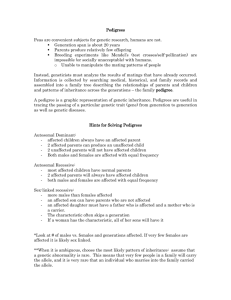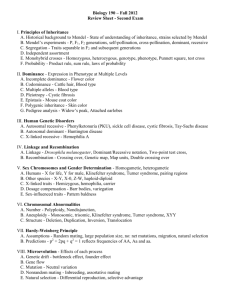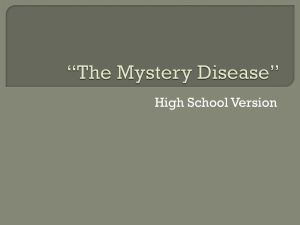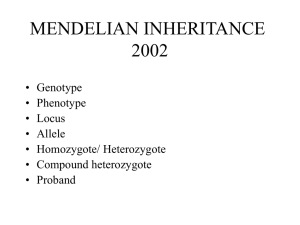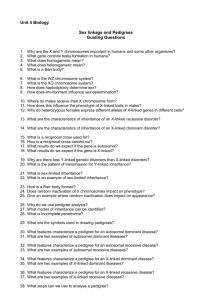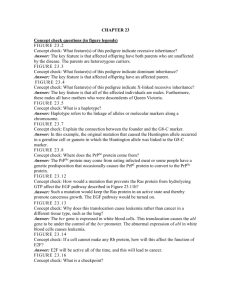outline29476
advertisement
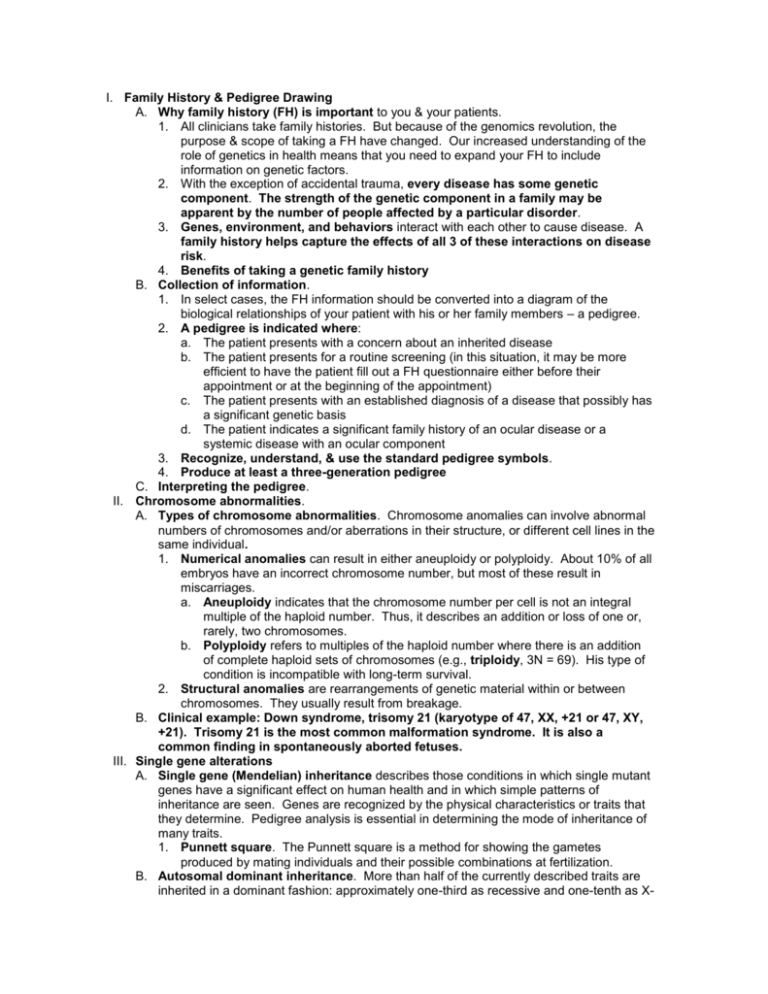
I. Family History & Pedigree Drawing A. Why family history (FH) is important to you & your patients. 1. All clinicians take family histories. But because of the genomics revolution, the purpose & scope of taking a FH have changed. Our increased understanding of the role of genetics in health means that you need to expand your FH to include information on genetic factors. 2. With the exception of accidental trauma, every disease has some genetic component. The strength of the genetic component in a family may be apparent by the number of people affected by a particular disorder. 3. Genes, environment, and behaviors interact with each other to cause disease. A family history helps capture the effects of all 3 of these interactions on disease risk. 4. Benefits of taking a genetic family history B. Collection of information. 1. In select cases, the FH information should be converted into a diagram of the biological relationships of your patient with his or her family members – a pedigree. 2. A pedigree is indicated where: a. The patient presents with a concern about an inherited disease b. The patient presents for a routine screening (in this situation, it may be more efficient to have the patient fill out a FH questionnaire either before their appointment or at the beginning of the appointment) c. The patient presents with an established diagnosis of a disease that possibly has a significant genetic basis d. The patient indicates a significant family history of an ocular disease or a systemic disease with an ocular component 3. Recognize, understand, & use the standard pedigree symbols. 4. Produce at least a three-generation pedigree C. Interpreting the pedigree. II. Chromosome abnormalities. A. Types of chromosome abnormalities. Chromosome anomalies can involve abnormal numbers of chromosomes and/or aberrations in their structure, or different cell lines in the same individual. 1. Numerical anomalies can result in either aneuploidy or polyploidy. About 10% of all embryos have an incorrect chromosome number, but most of these result in miscarriages. a. Aneuploidy indicates that the chromosome number per cell is not an integral multiple of the haploid number. Thus, it describes an addition or loss of one or, rarely, two chromosomes. b. Polyploidy refers to multiples of the haploid number where there is an addition of complete haploid sets of chromosomes (e.g., triploidy, 3N = 69). His type of condition is incompatible with long-term survival. 2. Structural anomalies are rearrangements of genetic material within or between chromosomes. They usually result from breakage. B. Clinical example: Down syndrome, trisomy 21 (karyotype of 47, XX, +21 or 47, XY, +21). Trisomy 21 is the most common malformation syndrome. It is also a common finding in spontaneously aborted fetuses. III. Single gene alterations A. Single gene (Mendelian) inheritance describes those conditions in which single mutant genes have a significant effect on human health and in which simple patterns of inheritance are seen. Genes are recognized by the physical characteristics or traits that they determine. Pedigree analysis is essential in determining the mode of inheritance of many traits. 1. Punnett square. The Punnett square is a method for showing the gametes produced by mating individuals and their possible combinations at fertilization. B. Autosomal dominant inheritance. More than half of the currently described traits are inherited in a dominant fashion: approximately one-third as recessive and one-tenth as X- linked. Dominant implies that the disease allele need be present only in a single copy (as in a heterozygote) to result in the phenotype. 1. The criteria of autosomal dominant inheritance include the following: a. Vertical inheritance pattern. The transmission of the trait is vertical, from generation to generation without skipping. In a typical dominant pedigree, there can be many affected members in each generation. b. Except for a new mutation or non-penetrance, every affected child will have an affected parent. Direct transmission through three generations is essentially diagnostic of dominant inheritance. c. In the mating of an affected heterozygote to a normal homozygote (the usual situation), each child has a 50% chance to inherit the abnormal allele and be affected and a 50% chance to inherit the normal allele. d. Males and females have an equal chance of having the condition. Thus, males and females are affected in roughly equal numbers. Since the loci are on the autosomes (i.e., nonsex chromosomes), a sex differential is not seen unless the mutant allele involves a sex-limited structure such as the uterus. e. Father-to-son transmission can be seen. f. The trait is expressed in the heterozygote but is more severe in the homozygote. 2. Features. To provide the most accurate counseling, a number of potential complicating factors are important to consider in autosomal dominant inheritance. Each of the following may alter the idealized dominant pedigree. a. New mutations. b. Reduced/variable penetrance. c. Variable expressivity. Expressivity refers to how or to what degree a particular allele is expressed in an individual. d. Variation in age of onset (e.g., in Huntington disease). Before the advent of molecular testing, the diagnosis could not be reliably ruled out in a young person. e. Mosaicism. If a parent is mosaic for a disease allele because of a postzygotic mutation, he or she may appear clinically unaffected. f. Genetic heterogeneity. Different mutations, at the same locus or at different loci, may result in a similar clinical picture. In addition, the conditions may be inherited in different manners (e.g., retinitis pigmentosa may be inherited as an autosomal dominant, autosomal recessive, or X-linked trait). g. AD disorders tend to involve genes that code for structural proteins. 4. Clinical examples a. Marfan syndrome. b. Juvenile-onset, open angle glaucoma. C. Autosomal recessive inheritance. The phenotype is usually only in the homozygote, and the typical pedigree demonstrates affected male and female siblings with normal parents and offspring. Recessive inheritance is suspected when parents are consanguineous; it is considered proven when corresponding enzyme levels are low or absent in affected individuals and are at half-normal values in both parents. 1. Criteria a. The mutant gene usually does not cause clinical disease in a heterozygote. b. Individuals who inherit both mutant genes will express the disorder. c. Horizontal inheritance pattern. The characteristic pattern of inheritance is horizontal. In other words, the disorder typically appears in only one generation (i.e., in a single group of brothers and sisters). The disorder is not found in multiple generations. If the trait is rare, parents and relatives other than siblings are usually clinically normal but heterozygous for the mutant allele. Thus, the parents are said to be carriers of the allele. d. In the mating of two normal heterozygotes, the segregation frequency with each pregnancy is 25% homozygous normal, 50% heterozygous normal, and 25% homozygous affected. An unaffected child of carrier parents has a 2/3 risk of being a carrier. e. If the recessive genes are alleles, all children of two affected parents are affected. f. Both sexes are affected in roughly equal numbers. g. Parents of an affected individual may be genetically related (consanguinity). If the trait is rare, the likelihood of parental consanguinity is increased. 2. Features. A number of features are important to keep in mind before counseling families regarding autosomal recessive inheritance. a. Heterozygote frequency. b. Carrier state. c. Consanguinity. d. Ethnicity: autosomal recessive phenotypes in the local population. e. Heterogeneity. For example, albinism or retinitis pigmentosa f. Most recessive genetic disorders involve an enzyme deficiency. g. AR disorders tend to be more severe, fully penetrant, and produce symptoms at much earlier ages, than AD disorders. 4. Clinical examples a. Tay-Sachs disease b. Stargardt disease / fundus flavimaculatus. D. X-linked inheritance can be either recessive or dominant, although in patients with a recessive X-linked condition, the phenotype is usually only observed in the male. Xlinked inheritance is suspected when several male relatives in the female line of a family are affected. Because males have only one X chromosome, they are hemizygous, not heterozygous, for X-linked genes. 1. Criteria a. Predominance of affected males. X-linked disorders are due to mutant alleles on the X chromosome. Since males have only one X chromosome, X-linked mutant genes are fully expressed in males. In females heterozygous for an Xlinked mutant gene, an X-linked trait may or may not be expressed because of lyonization. If a disease is rarely expressed clinically in a heterozygous female, it is called X-linked recessive. In fact, most cases of X-linked inheritance are recessive. b. If the trait is rare, parents and relatives (except maternal uncles and other male relatives in the female line) are usually normal. c. Hemizygous affected males have neither affected sons nor daughters. All daughters of affected males are obligate heterozygotes (i.e., they do not show a mutation clinically but carry the mutant allele). There is no male-to-male transmission. d. Female heterozygous carriers are clinically normal but will transmit the trait to sons (i.e., hemizygous affected) 50% of the time. Daughters of carrier mothers are normal heterozygotes (i.e., carriers) 50% of the time and normal homozygotes 50% of the time. e. Most often, affected daughters are produced only by matings of heterozygous females with affected males. f. Except for those with new mutations, every affected male is born of a heterozygous female. g. If the trait is X-linked dominant: (1) All female offspring of affected males will themselves be affected (often less severely affected than males). (2) On average, 50% of either male or female offspring of an affected female heterozygote will be affected since females transmit the gene to half of their daughters and half of their sons. (3) The condition may be lethal in affected males. Thus, there may be fewer males in a family than expected. There may be a history of multiple miscarriages (due to lethality in male fetuses). (4) Unlike autosomal dominant pedigrees, there is no male-to-male transmission. So affected males transmit the gene to all of their daughters and none of their sons. 2. Features. Some specific features of X-linked inheritance that cause problems are important to keep in mind. a. The sporadic case. If a male is affected but there are no other affected family members, the question is whether the condition is the result of a new mutation or whether the mother is heterozygous. Heterozygous females may be detected by subtle clinical features, intermediate enzyme levels, or molecular methods. In about 2/3 of cases of X-linked recessive diseases that are lethal in childhood and in which there is only one affected male in the family, the mother is heterozygous. In 1/3 of cases, the son has a new mutation. b. Heterogeneity. Diseases with similar clinical features may be inherited through differing mechanisms. (1) Albinism is usually inherited as an autosomal recessive condition, with involvement of eyes, hair, and skin. (2) An X-linked recessive form, ocular albinism, primarily involves the eyes, with little skin and hair involvement. The condition may be misdiagnosed in a blond child and incorrect counseling provided. (3) A good clinical examination and family history are essential. c. Affected females. X-linked conditions affecting females can be explained by a number of mechanisms, including random X chromosome inactivation (lyonization). d. New mutations. New mutations are common in XLR disorders (e.g., in Duchenne muscular dystrophy). 4. Clinical examples. a. Protan (red cone pigment) color deficiency. About 2% of western European males have a color deficiency due to red cone pigment involvement. b. Deutan (green cone pigment) color deficiency. About 6% of western European males have a color deficiency due to green cone pigment involvement. E. Mitochondrial inheritance. Human cells have hundreds of mitochondria dispersed throughout the cytoplasm, each containing a number of circular DNA molecules. Mutations involving the mitochondrial DNA are now known to account for a small number of genetic conditions. 1. Criteria. a. Each mitochondrion contains a number of copies of the circular genome. Mitochondrial enzymes are usually encoded by nuclear genes, but some of the cytochrome oxidase enzymes are derived solely from mitochondria. b. Almost all mitochondrial DNA is maternally inherited. Pedigrees with mitochondrial inheritance should show that all children of an affected mother are affected and all children of an affected father are normal. Vertical transmission can occur; but no transmission from males. c. The same cell may contain a mixture of mitochondria, those containing normal and abnormal mtDNA. When cells divide, there is random segregation of mitochondria to the daughter cells. Thus, the proportion of mutant-to-normal mitochondria can vacillate above and below a disease-causing threshold. This influences the phenotype and can lead to variable expressivity. It may also make prediction of transmission and severity difficult. 1) Homoplasmy. All mitochondria have mutated mtDNA. 2) Heteroplasmy. Both mutant and normal mtDNA are found in the mitochondria. d. The most severe mitochondrial disorders in individuals are heteroplasmic. Homoplasmy is usually so severe that embryonic development is prevented. e. Specific tissues have different proportions of mitochondria. Rich areas include striated and cardiac muscle, the kidney, and the central nervous system (CNS), including the eyes. Therefore, mitochondrial diseases are commonly myopathies, neurologic syndromes, cardiomyopathies, and optic neuropathies. Mutations in the mitochondrial DNA encoding enzymes required for oxidative phosphorylation can result in reduction of ATP, generation of reactive oxygen species like free radicals, and induction of apoptosis. f. Heteroplasmic mitochondrial disorders are often not manifest until adulthood. This is because many cell divisions are necessary to produce enough mutant alleles in the mitochondria. 2. Clinical examples: a. Kearns-Sayre syndrome. b. Leber hereditary optic neuropathy (LHON). IV. Complex (multifactorial) disorders A. Complex (multifactorial) disorders are the most common type of disorders seen in practice. B. Multifactorial inheritance is a pattern of inheritance that results from the interaction of one or more genes with environmental factors. Thus, a multifactorial trait has a familial nature and an environmental dependence. C. Most normal phenotypic differences among individuals are due to multifactorial inheritance. This includes differences in height, hair and skin color, and intelligence. D. Clinical characteristics of complex disorders. 1. These disorders can be common (> 1/5000 births). 2. The disorder tends to be familial, but there is no distinctive pattern of inheritance within a single family. 3. The theoretical risk of first-degree relatives is approximately the square root of the population occurrence (I1/2), if the inheritance is determined by an underlying defect that is normally distributed. The risk of second-degree relatives is about I¼ and of third-degree relatives is about I1/8. 4. If the underlying genetic mechanism is not known, then empiric risk is used instead of theoretic risk. Family studies can be used to establish the occurrence in various relatives, and thus the empiric risk. 5. Recurrence risk is proportional to the number of family members who already have the disease. 6. Recurrence risk is proportional to the severity of the condition in the proband. 7. The recurrence risk is the same for all relatives who share the same proportion of genes. 8. The frequency of disease in second degree relatives is much lower than in first degree relatives. However, the frequency declines less rapidly for more distant relatives. 9. The concordance rate in monozygotic (MZ) twins is significantly greater than in dizygotic (DZ) twins. 10. Multifactorial diseases are more common among the children of consanguineous parents. 11. Complex diseases tend to occur more frequently in one sex than in the other. 12. Recurrence risk is higher for relatives of the less susceptible sex. 13. Consanguinity slightly increases the risk of an affected child. E. Clinical examples. 1. Type 1 diabetes mellitus (T1DM) 2. Type 2 diabetes mellitus (T2DM) 3. Age-related macular degeneration (AMD). V. Identifying genetic red flags A. Family history of a known or suspected genetic condition. B. Multiple affected family members with the same or related disorders. C. Earlier age at onset of disease than expected. D. Developmental delays or mental retardation. E. Diagnosis in less-often-affected sex. F. Multifocal or bilateral occurrence in paired organs. G. Blood relationship of parents (consanguinity). H. Ethnic predisposition to certain genetic disorders. I. One or more major malformations. J. Abnormalities in growth (e.g., excessive growth, retarded growth, or asymmetric growth). K. Recurrent pregnancy losses (2+). L. Disease in the absence of risk factors. VI. Interpretation. A. Eliciting and summarizing FH information can: 1. Help the patient understand the condition in question 2. Clarify any patient misconceptions 3. Help the patient recognize the inheritance pattern 4. Demonstrate variation in disease expression (e.g., different ages at onset) 5. Provide a visual reminder of who in the family is at risk for the disorder 6. Emphasize the need to obtain medical documentation on affected family members B. Cautions & constraints. C. Barriers to use of the FH. D. Using the FH to guide & inform prevention. Figure 1. Suggested Risk Stratification. VII. Possible interventions: A. Identify where more specific information is need & obtain records B. Assess general risks C. Know when to refer to a genetics professional D. Encourage the patient to talk with other family members E. Update the pedigree at further visits F. Earlier & more frequent screening G. Education about symptoms H. Prophylactic surgery I. Environmental/lifestyle changes (e.g., take or avoid certain medications; lifestyle changes like diet, exercise, habits VIII. Available FH tools. A. The Surgeon General’s Family History Initiative: “My Family Health Portrait” (www.hhs.gov/familyhistory). This is an excellent tool to use with patients. B. The CDC’s “Genomics Translation. Family History Public Health Initiative” (www.cdc.gov/genomics/famhistory/famhist.htm) C. The AMA’s “Genetics & Molecular Medicine: Family Medical History” (www.amaassn.org/ama/pub/category/2380.html) D. NSGC/Genetic Alliance/ASHG “Your Family History – Your Future” IX. How to find a genetics professional or a genetics clinic. A. National Society of Genetic Counselors (www.nsgc.org). Find a counselor according to location, institution, or area of specialization. B. American College of Medical Genetics (www.acmg.net). Click on “Find a Member.” Then enter your city and state. You may also click on “Find Genetic Services,” and search by type of service, city, state, or zip code. C. GeneTests (www.ncbi.nlm.nih.gov/sites/GeneTests/). This includes a voluntary listing of U.S. and international genetics clinics that provide genetic evaluation and counseling. D. American Society of Human Genetics (www.ashg.org). Click on “Membership” and then “Membership Directory.” X. How to find disease specific genetic information for health care professionals. A. Online Mendelian Inheritance in Man (OMIM) (www.ncbi.nlm.nih.gov/sites/entrez?db=OMIM) B. GeneTests (select “GeneReviews”) (www.ncbi.nlm.nih.gov/sites/GeneTests/) C. Genes and Disease (NCBI) (www.ncbi.nlm.nih.gov/disease/) D. RetNet (Retinal Information Network) (www.sph.uth.tmc.edu/retnet/)

